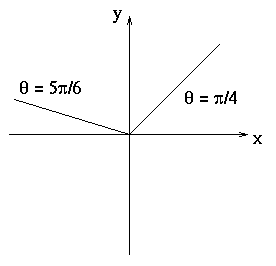You should be familiar with polar coordinates from trigonometry. Here, the
coordinates of a point in the plane are expressed by r and
![]() where
r is the distance of the point from the origin, and
where
r is the distance of the point from the origin, and ![]() is the angle
(in radians) between the x-axis and a line segment joining the origin and
the point.
is the angle
(in radians) between the x-axis and a line segment joining the origin and
the point.

A simple bit of algebra will show that
![]()
![]()
So, if we have a function in Cartesian coordinates that is f(x,y) = x2 +
y2, we can write this in polar coordinates as ![]() .
.
Notice that the curves r = r0 describe circles of radius r0 in the
xy-plane, while the lines ![]() describe straight lines
through the origin at an angle
describe straight lines
through the origin at an angle ![]() from the x-axis.
from the x-axis.

